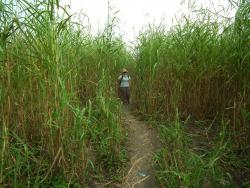Reading the Signs
By Calista Pearce

Paying attention to indicators contributes to being able prevent violent conflict, and can also mitigate its impact when it does occur. So, what are the indicators to look for when a community is coming back to life? What does peace and security look like?
Most of this town’s residents fled in January and May of 2013. The few who stayed were displaced to makeshift shelters within a government compound. They lost most of their possessions and livelihoods. They had lived through the shootings, shelling, and beatings in their community. Many had their homes destroyed. Surrounded by armed actors, they lived in fear – their town had become military camp more than a civilian community.
One day in the midst of the conflict, we heard the sound of children singing. It was as if we had heard a siren’s call. In the middle of the town there was an open space filled with children. A few young boys were playing drums in the front, and four young men led the group. In total there were around 70 children singing and dancing. It is difficult to explain how beautiful and incongruous this sight was.
The young men were a mix of civilians and soldiers from the local community, and this was the start of a regular activity that culminated in singing in church on Sunday. One
young man explained, “Many people have died, but we are alive. We need to share what we have. We need to praise God and pray and sing and dance for peace.”
The community also first restarted their Sunday service under a tree, and as the situation stabilized they were able to hold their service in a nearby primary school. Most recently, they reclaimed their actual church building across town. Volunteers cleaned and cleared the compound to make it useable again, as it had been looted and was overgrown. This was not just a physical relocation of their Sunday morning gathering place; this action also carried a greater message about self-determination as a community and everyone’s sense of security.
NP has also collaborated during the past year with an amazing local women’s leader, Nyandit.* We turned to her again last month for help getting emergency assistance to the most vulnerable in town. This emergency assistance, distributed by INGO’s and UN humanitarian agencies, comes in the form of food, plastic sheets, mosquito nets, soap and such forth. Nyandit worked tirelessly to help locate and identify the elderly, mothers who had newly delivered, the sick, or those who were disabled. She mobilized volunteers for collecting and delivering of distribution items in the community.
We are amazed at the resiliency of the community and the dedication of its leaders.
NP does not rely solely on our own determination of indicators. We also ask the community what peace and security look like. One local woman explained that she now feels safe enough to go to the river to bathe whenever she wants. There is no one at her door at night threatening her either.
We do not know what the next couple of months will bring. Dry season is coming. That has the potential to change the situation for better or worse. We continue to watch the indicators and do what programming we can. We hope to see many more signs of the community returning to its normal life.
*Name changed to protect privacy.
